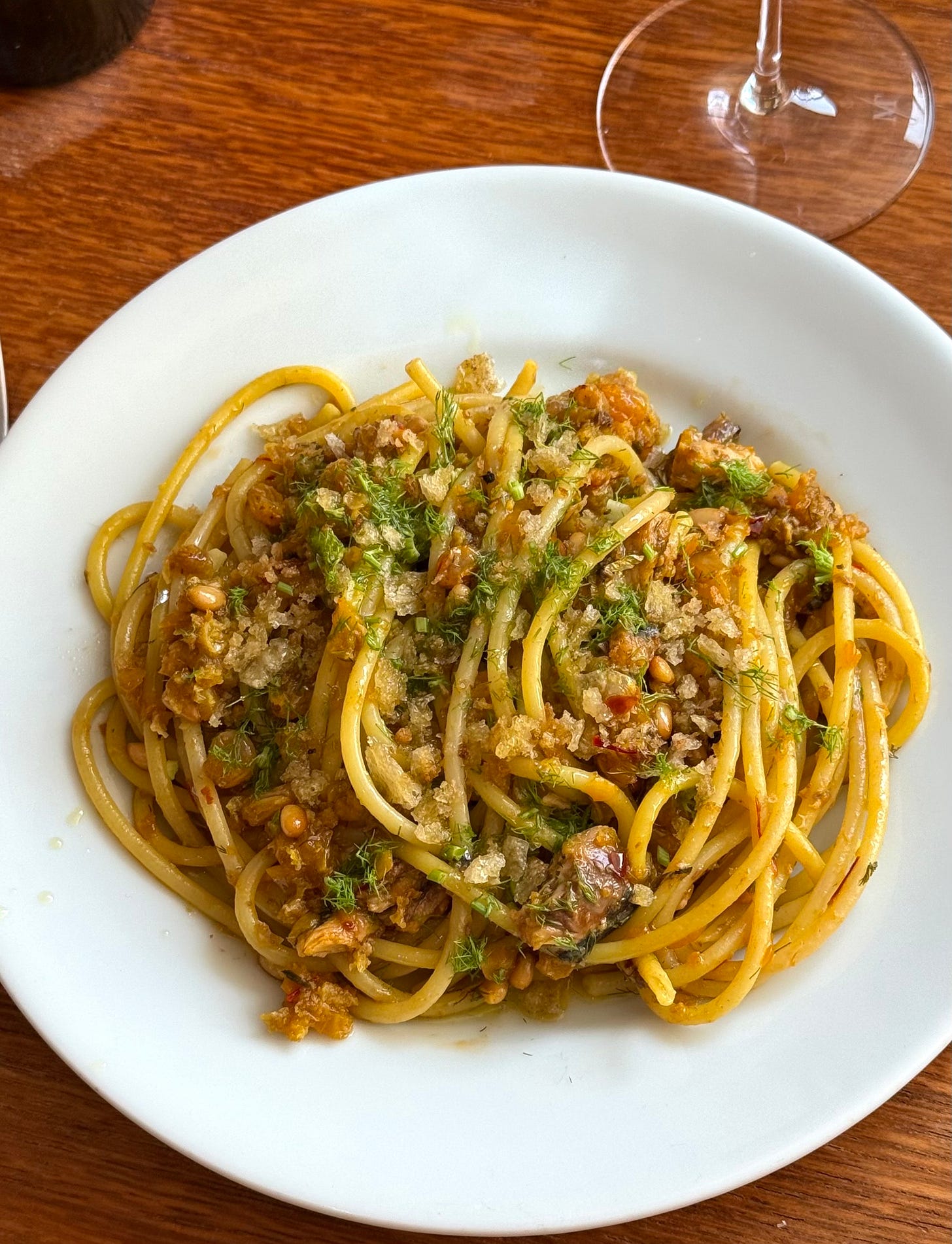Nick Bramham’s Bucatini Con Le Sarde
A classic Sicilian pasta dish made with tinned sardines, fennel, and pine nuts that’s ready in under thirty minutes. Words and images by Nick Bramham.
Good morning, and welcome to Vittles! Today, Nick Bramham shares his recipe for bucatini con le sarde, an iconic Sicilian pasta dish.
Pre-orders for Issue 1 of Vittles are now closed until next week. We will start sending out magazines from the week of 5 May before reopening orders again (apologies that this is a few days later than originally expected).
Bucatini Con Le Sarde
A classic Sicilian pasta dish made with tinned sardines, fennel, and pine nuts that’s ready in under thirty minutes.
This recipe for bucatini con le sarde – a perhaps initially unusual-sounding Sicilian pasta dish of sardines, wild fennel, pine nuts, and raisins – is tried and tested. I’ve served it at the restaurant many times, and I also make it regularly at home. This evening, before I cook it for my wife and I, and knowing I’m probably going to write it up for this column, I begin to worry about the ways I may have deviated wildly from convention. I consult a couple of my favourite Sicilian cookbooks to clear things up. I’ve also recently been enjoying Helena Attlee’s beautifully lyrical history of citrus fruit in Italy, The Land Where Lemons Grow, as well as doing some light reading on the Arab conquest of the Mediterranean, so there are lots of interconnected thoughts and ideas swirling around my mind as I gather my mise en place.
Wild fennel – which is key to many Sicilian dishes – grows like a weed all over the island (by the side of the road, in the cracks of the dry stone walls) and has a much stronger, almost menthol-like anise flavour than the domesticated variety that’s common in the UK. Purists would say that if you’re not using wild fennel, then it is not bona fide bucatini con le sarde. However, given that it’s almost impossible to buy wild fennel here (though you can forage it in the summer), I’m happy using the perfectly tasty domesticated stuff and leaning into the dish’s other bold flavours instead.
My other controversial compromise is to use tinned sardines rather than fresh. This is driven by convenience more than anything (fresh sardines are not currently in season), but good-quality tinned sardines are a wonderful thing regardless – tender, meaty, flavourful, relatively cheap – and I know that if I carefully break them into chunks over the finished sauce, the residual heat will gently warm them through, preserving their structural integrity to more effectively mimic just-cooked fresh sardines (too much heat or stirring will quickly turn them into unappetising mush).
At peace with my deviations, I get to work. I finely chop a small bulb of fennel and a similarly sized onion and add them to a pan with a big glug of olive oil and a pinch of salt. I scatter in some chilli flakes (a surprise third deviation! No other recipe for bucatini con le sarde will endorse this, but I love the gentle background heat it brings). While the vegetables gently simmer in oil, I bloom the golden raisins and saffron in a little white wine. As the raisins slowly swell, streaked amber and crimson, I consider how Middle Eastern this aspect of the dish feels, especially once combined with the pine nuts.
Lemons, oranges, rice, aubergines, and pistachios – all of which are now synonymous with Sicily – were introduced during Islamic rule, and it’s now widely thought that pasta itself was brought to Sicily by Arab conquerors, who mixed milled durum wheat with water to make dry strands of dough known as itrya centuries before Marco Polo ‘discovered’ pasta in China in the popular – and apocryphal – story. Olives and viticulture were introduced to the island by the ancient Greeks – imagine Sicily without wine or olive oil – while the Phoenicians before them, experts in fish preservation, established the famous Trapani salt flats that still produce Sicily’s ‘white gold’ to this day. Tomatoes and chillies were brought from the Americas by returning conquistadors in the 1500s, when Sicily was under Spanish dominion.
Is there any other dish that so acutely encapsulates a country’s successive waves of conquest as bucatini con le sarde? I’m pondering this highfalutin question while I drop the bucatini into boiling salted water and dissolve anchovy fillets and a spoonful of tomato purée in the softened fennel and onions. The waft of savoury aromas that hits me in the face is so pronounced it makes my mouth water. The raisins, saffron, and wine go in, followed by the pine nuts. I break over the sardines, then add the cooked pasta, the breadcrumbs, and the chopped fennel fronds.
I’m certainly not equipped to answer the question – but does it matter anyway? What’s more important for our purposes is that this dish is absolutely delicious. Even better, it can be put together in less than half an hour, and relies heavily on staples and store cupboard ingredients – a bougie store cupboard, I admit, but once you’ve got the required ingredients you’ll have enough left over to make this dish a few more times in future. A little of each goes a long way.
I lift the pasta onto plates, spoon over the sauce left in the pan, and sprinkle over some more breadcrumbs. Kicking back with a cold bottle of fragrant Zibibbo, I make the mistake of vocalising an idle daydream that, if you ignore the tomato and chilli, we might be enjoying a meal quite similar to what the Emir of Sicily would have eaten over a thousand years ago in what is now Palermo. I get an eye-roll from my wife in return. Fair.
Bucatini Con Le Sarde
Serves 2
Time 30 mins




